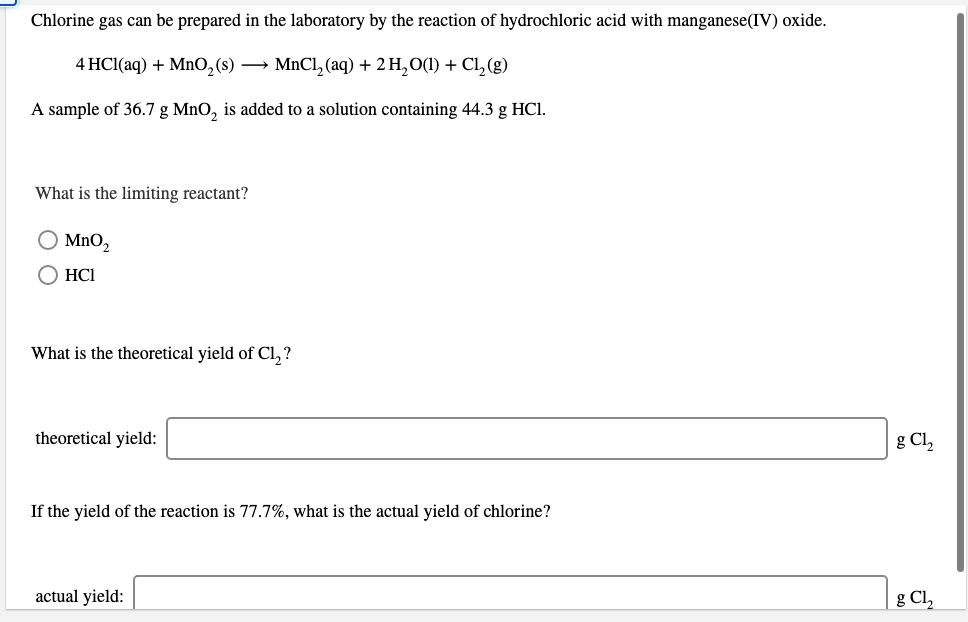Chlorine gas can be prepared in the laboratory by the reaction of hydrochloric acid with manganese(IV) oxide. 4 HCl(aq) + MnO,(s) → MnCl, (aq) + 2 H,O(1) + Cl,(g) A sample of 36.7 g MnO, is added to a solution containing 44.3 g HCI. What is the limiting reactant? MnO, HCI What is the theoretical yield of Cl, ? theoretical yield: g Cl, If the yield of the reaction is 77.7%, what is the actual yield of chlorine? actual yield: g Cl,
Chlorine gas can be prepared in the laboratory by the reaction of hydrochloric acid with manganese(IV) oxide. 4 HCl(aq) + MnO,(s) → MnCl, (aq) + 2 H,O(1) + Cl,(g) A sample of 36.7 g MnO, is added to a solution containing 44.3 g HCI. What is the limiting reactant? MnO, HCI What is the theoretical yield of Cl, ? theoretical yield: g Cl, If the yield of the reaction is 77.7%, what is the actual yield of chlorine? actual yield: g Cl,
Chemistry & Chemical Reactivity
10th Edition
ISBN:9781337399074
Author:John C. Kotz, Paul M. Treichel, John Townsend, David Treichel
Publisher:John C. Kotz, Paul M. Treichel, John Townsend, David Treichel
Chapter4: Stoichiometry: Quantitative Information About Chemical Reactions
Section: Chapter Questions
Problem 14PS: Disulfur dichloride, S2Cl2, is used to vulcanize rubber. It can be made by treating molten sulfur...
Related questions
Question
please help with all the parts in this question, it is practice so I want to have all the parts to study

Transcribed Image Text:Chlorine gas can be prepared in the laboratory by the reaction of hydrochloric acid with manganese(IV) oxide.
4 HCl(aq) + MnO,(s)
MnCl, (aq) + 2 H,0(1) + Cl, (g)
A sample of 36.7 g MnO, is added to a solution containing 44.3 g HCl.
What is the limiting reactant?
MnO,
HC1
What is the theoretical yield of Cl, ?
theoretical yield:
g Cl,
If the yield of the reaction is 77.7%, what is the actual yield of chlorine?
actual yield:
g Cl,
Expert Solution
This question has been solved!
Explore an expertly crafted, step-by-step solution for a thorough understanding of key concepts.
This is a popular solution!
Trending now
This is a popular solution!
Step by step
Solved in 5 steps with 5 images

Knowledge Booster
Learn more about
Need a deep-dive on the concept behind this application? Look no further. Learn more about this topic, chemistry and related others by exploring similar questions and additional content below.Recommended textbooks for you

Chemistry & Chemical Reactivity
Chemistry
ISBN:
9781337399074
Author:
John C. Kotz, Paul M. Treichel, John Townsend, David Treichel
Publisher:
Cengage Learning

Chemistry & Chemical Reactivity
Chemistry
ISBN:
9781133949640
Author:
John C. Kotz, Paul M. Treichel, John Townsend, David Treichel
Publisher:
Cengage Learning

Chemistry for Engineering Students
Chemistry
ISBN:
9781285199023
Author:
Lawrence S. Brown, Tom Holme
Publisher:
Cengage Learning

Chemistry & Chemical Reactivity
Chemistry
ISBN:
9781337399074
Author:
John C. Kotz, Paul M. Treichel, John Townsend, David Treichel
Publisher:
Cengage Learning

Chemistry & Chemical Reactivity
Chemistry
ISBN:
9781133949640
Author:
John C. Kotz, Paul M. Treichel, John Townsend, David Treichel
Publisher:
Cengage Learning

Chemistry for Engineering Students
Chemistry
ISBN:
9781285199023
Author:
Lawrence S. Brown, Tom Holme
Publisher:
Cengage Learning

Chemistry for Engineering Students
Chemistry
ISBN:
9781337398909
Author:
Lawrence S. Brown, Tom Holme
Publisher:
Cengage Learning

Chemistry: The Molecular Science
Chemistry
ISBN:
9781285199047
Author:
John W. Moore, Conrad L. Stanitski
Publisher:
Cengage Learning

World of Chemistry
Chemistry
ISBN:
9780618562763
Author:
Steven S. Zumdahl
Publisher:
Houghton Mifflin College Div